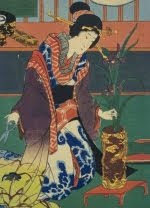Friday, 31 December 2010
A Ship of Good Fortune
Friday, 24 December 2010
Red and White for Christmas
Tuesday, 21 December 2010
Web Greetings

Tuesday, 14 December 2010
More Christmas
Monday, 13 December 2010
White Christmas
Thursday, 9 December 2010
Purple for Advent
Tuesday, 7 December 2010
Collage Lotus

Sunday, 5 December 2010
Scrapbook Traditions

Wednesday, 1 December 2010
Anticipation and Originality
Anticipation or being enthusiastic, is an emotion involving pleasure (and sometimes anxiety) in considering some expected or longed-for good event. (Wikipedia)
Tuesday, 30 November 2010
Facing the Winter Naked
Monday, 29 November 2010
More Water


Friday, 26 November 2010
Ikebana + Bass Performance
Have a look at this video - improvised bass music and ikebana creations in Japanese ceramics. Now that's an innovative and original concept! I love the way the clipping sound from the ikebana scissors becomes part of the music.
Monday, 15 November 2010
Stylized Gestures
One thing that fascinates me about traditional Japanese culture is the thoroughness - the focus on the details. I've been writing in earlier posts about practicing ikebana as a flower ceremony with a set of rules for how to move. It's similar to tea ceremony in the movements and is still practiced by some traditional ikebana schools.
I found this video on YouTube and decided to post it on the blog because of the gestures of the kadoka, the ikebana artist, as she creates a traditional Seika arrangement in what looks like a bamboo vase. The school is Saga Goryu, an ikebana school that goes back to the Emperor Saga in the 9th century and the style of flower arrangement that is said to have been created by him.
Monday, 1 November 2010
Water: Reflecting Heaven
Thursday, 28 October 2010
Flowing Energy

Friday, 15 October 2010
Day 7 - Simple Living
Thursday, 14 October 2010
Day 6 - A Closer Look
Wednesday, 13 October 2010
Day 5 - Outdoor Meditation in Action
Tuesday, 12 October 2010
Day 4 - The Beauty of the Imperfect
Monday, 11 October 2010
Day 3 - Three Vases and What's Left on the Trees
Sunday, 10 October 2010
Day 2 - Mother and Child in Autumn Dew
Saturday, 9 October 2010
Day 1 - Flower Practice Week
Saturday, 2 October 2010
Warhol Watercolour Variations




Friday, 1 October 2010
Moon Viewing
Sunday, 26 September 2010
Plastic is Fantastic
The Story of a Tea House

Saturday, 18 September 2010
Leftover Sunbeams
Saturday, 11 September 2010
Earthy Colours
Wednesday, 1 September 2010
A Moment - Michiko Takahashi Nilsen

Wednesday, 7 July 2010
Ikebana Gift Basket Surprise
Drifting Away
Thursday, 1 July 2010
Again and Again
"Again and again again again again again
Never stop
Again and again again again again again
Never stop oh" (Lady Gaga)
Actually you got to be able to stop when there is balance. It's just that when the form is clean it can sometimes take much more than you think.












